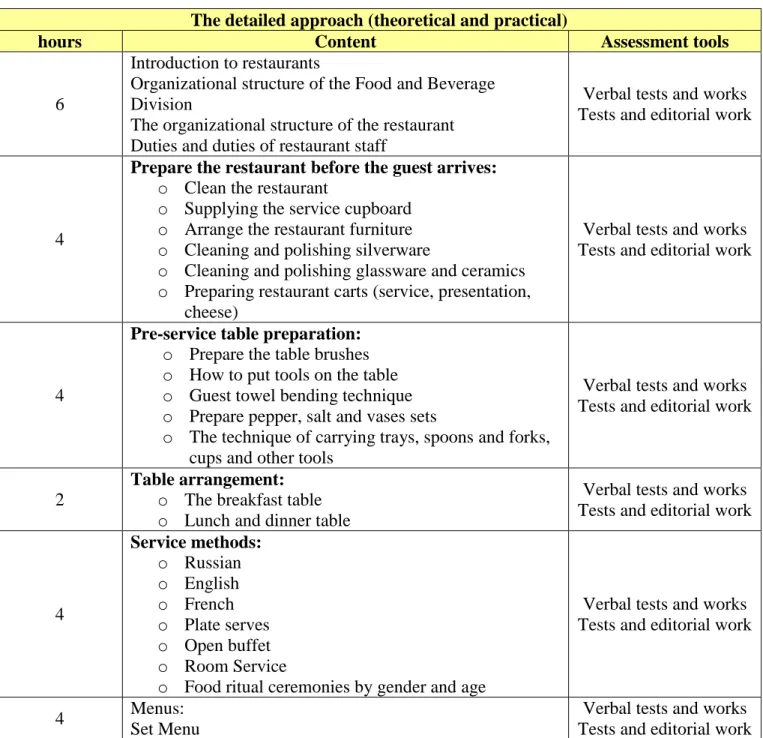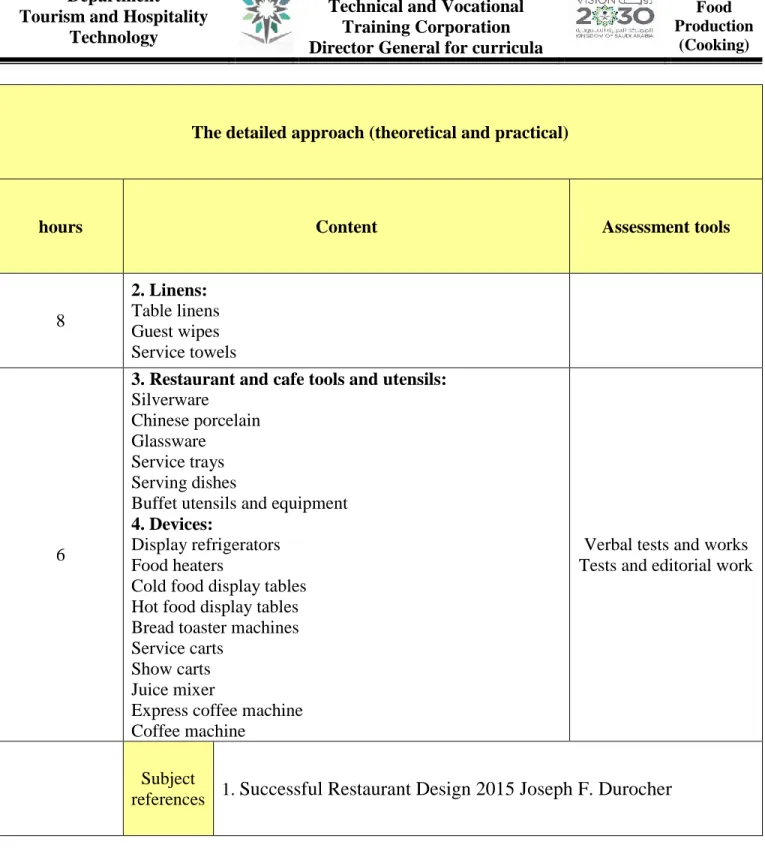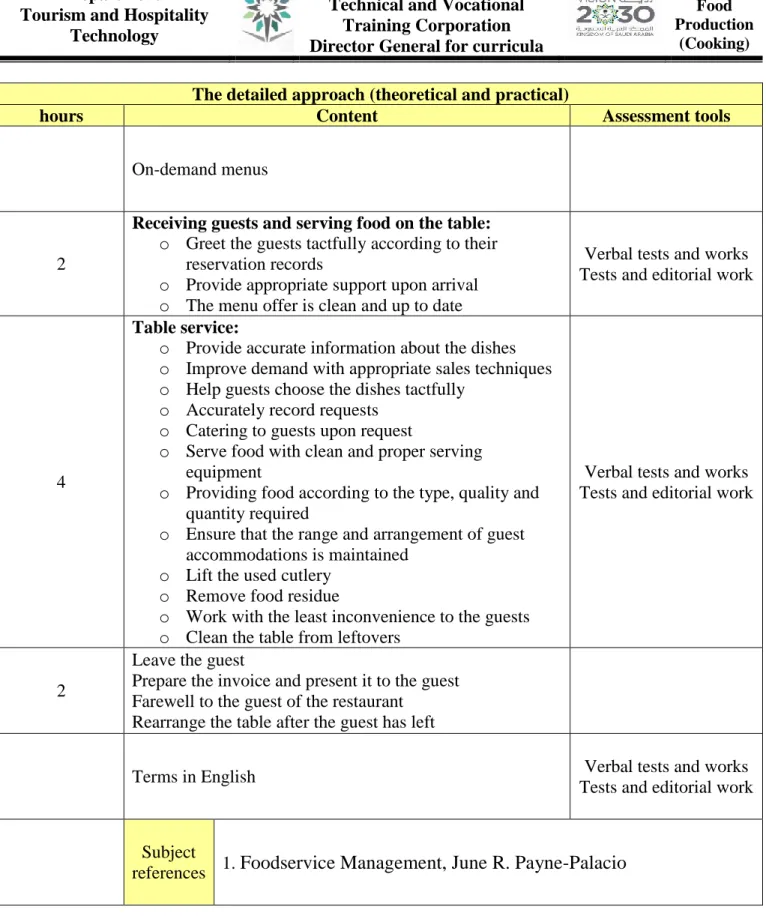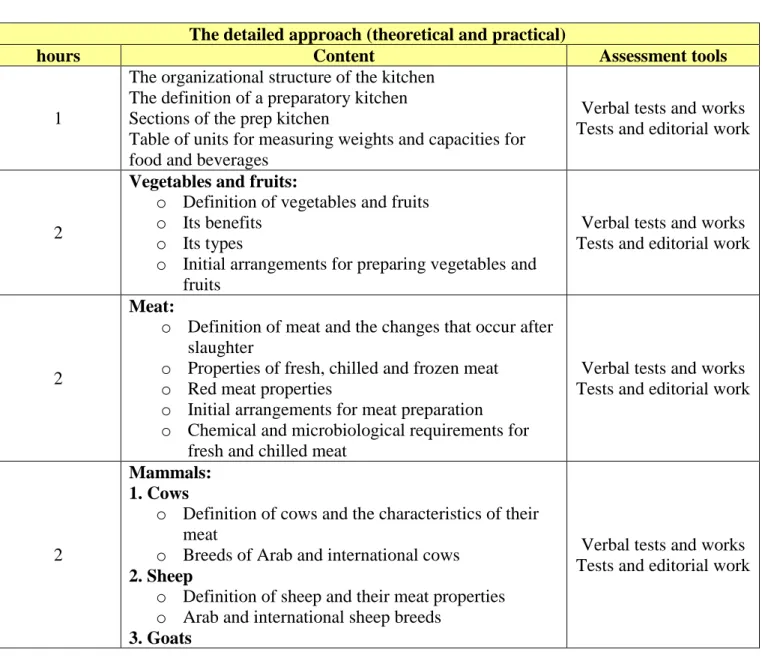This course deals with the trainee's definition of the tourism and hospitality industry, the food and beverage industry and its types and the importance of each industry at the socio-economic and cultural level. Through this course, skills training in the use and operation of equipment and equipment for kitchens, restaurants and cafes, knowledge of the factors that govern the selection of equipment, equipment and tools are taught. This course seeks to provide the trainee with the necessary skills in food health and safety through the identification of food and the importance of personal health and safety and the identification of the causes of foodborne illnesses and their relationship to poisoning, as well as the correct ways of handling food through the application of safe work practices (HACCP) and training To prepare dishes taking into account special cases.
This course is designed to equip the student with skills in monitoring the cost of food and drink, choosing food commodities, calculating cost and inventory, and controlling piece size through training on the steps of the process of purchasing and monitoring food and linking it with costs. This course examines the trainee's definition of the tourism and hospitality industry, the food and beverage industry and its types, and the importance of each industry on an economic and cultural level. This course is designed to provide the trainee with the basic skills to understand the importance of the tourism and hospitality industry and to know the nature of the types and services offered by each sector.
The trainee learns about the development of the food and beverage industry within 8 hours of training. During this course, skills training in the use and operation of equipment and equipment for kitchens, restaurants and cafes is acquired, knowledge of the factors that govern the selection of equipment, equipment and tools.
Furniture the tables
Linens
Restaurant and cafe tools and utensils
This course aims to provide the trainee with the necessary skills in food health and safety, from. The trainee applies the principles of personal health and safety to himself within the 4 hours of training. The trainer must be aware of the effect of healthy eating on maintaining health within 4 hours of training.
That the intern himself enumerates the needs of the kitchen using prototype materials and menus within 3 tour hours. The student himself determines the specifications of the materials through the calibration within 3 tour hours. The student must take stock of the various shops themselves using the required forms within 3 tour hours.
This course aims to provide the trainee with basic knowledge and skills in occupational health and safety. The trainee determines the duties and tasks of the restaurant staff within two training hours. This course aims to provide the trainee with skills in controlling and calculating food and beverage costs.
The intern explains the importance of monitoring food and beverage costs within 3 hours of training. The intern creates food and beverage expense reports using papers and programs within 3 hours of training. The trainee adjusts the size of the piece while working in the kitchen within 3 hours of training.
In 4 lessons, the trainee learns how to manage the work of individuals in the kitchen. The trainee plans the kitchen before the food production phase within two hours of training 4. The trainee must coordinate food production operations for buffet service within 4 hours of training 8.
The student must master the types and cuts of the fish himself within 21 training hours. The organizational structure of the kitchen The definition of a preparation kitchen Section of the preparation kitchen.

Cows
Goats
The Camels
Turkey
Ducks
Quail birds: Definition of quail birds and the properties of their meat
Through this course, the apprentice is equipped with skills in cold kitchen work, preparation of sauces, Arabic and international salads of all kinds, cold sandwiches. The trainee determines the tasks and duties of the Cold Kitchen Department staff within 1 hour of training. The trainee can prepare sauces of all kinds by himself and using recipes within 4 hours of training.
Within 30 training hours, the trainee prepares the Arab and international salads himself on the basis of recipes. The organizational structure of the refrigerated kitchen Tasks and tasks of the refrigerated kitchen employees The main raw materials used in the refrigerated kitchen (cheese, cooked meat, vegetables, herbs and spices). Through this course, the student is taught skills in cold kitchen work, preparing sauces, hot and cold snacks, food that is eaten by hand.
The trainee can prepare hot and cold appetizers themselves, using recipes, within 40 hours of training. The intern must prepare edible food by hand and using recipes within 16 hours of training.
Cold
This course aims to give the trainee the skills to work in a hot kitchen. The trainee determines the tasks and duties of the hot department staff within two hours of the training. The trainee must distinguish between types of juices, sauces and soups during the 5 hours of training 7.
For the trainee to prepare his own types of juices, sauces and soups and using recipes within 10 hours. The trainee can prepare simple poultry and game dishes themselves using recipes within 10 hours of training. The trainee can prepare simple red meat dishes themselves using recipes within 10 hours of training.
The trainee can prepare the various simple starch dishes himself using recipes within 5 hours of training. The trainee can prepare several simple intestinal dishes by himself using recipes within 5 hours of training. The trainee can prepare complex poultry and game dishes himself using recipes within 10 hours of training.
The trainee can prepare complex red meat dishes himself using recipes within 10 hours of training. The trainee can prepare several complex intestinal dishes by himself using recipes within 5 hours of training. The trainee summarizes the duties and tasks of the staff of the confectionery department within 1 training hour.
The trainee mastered the preparation of creams and sauces on his own in 8 hours of practice. The trainee mastered the preparation of the oriental dessert on his own during 32 hours of practice. In 32 training hours, the trainee mastered the independent preparation of a Western dessert.
In 8 training hours, the trainee learns to independently decorate and serve dessert 11. The trainee mastered the preparation of bakery pastries in 32 training hours by himself in practical use.
Appendices and references
Oral tests
During various teaching and training situations, an assessment tool is used to obtain verbal responses from the trainee on a specific issue or topic. This tool aims to test the trainee's ability to use their previous information and the way to collect and organize it for oral presentation. This tool is a method of groupthink that relies on verbal discussion to support or reinforce an idea.
This tool, in addition to being an assessment tool, can be used to develop and strengthen the trainee's expressiveness and to strengthen his ability to listen and dialogue and his confidence. Oral presentation and participation in the discussion when presenting training cases or presenting the work and activities carried out by the group or trainee. An assessment tool is used throughout various education and training situations where paper and pen are used to elicit written responses from the trainee on a specific topic or topic.
Its purpose is to test the trainee's ability to use their previous information and how to collect and organize it for presentation in written images. These are the tests and tasks that the intern performs in class (learning class or workshop) and under the direct supervision of the lecturer, as well as the tasks that the practitioner prepares and prepares to be performed in class, including knowledge tests. Objective Tests: The concept of objective tests is determined by how far they are from the term subjectivity in treating the evaluated score in a way that is not different from another.
- Practical performance
Essay tests: These tests include open-ended questions and leave the trainee free to organize, edit and express answers and information in their own way. They are called essay tests because they organize and express answers and information in their own way. They are called essay tests because their questions usually require writing several lines, and one of the disadvantages of this method is that the questions are not specific.
Some questions are answered freely while some essay questions focus on limited answers. It is the written work and activities that the trainee carries out outside the classroom situation, which are works, questions or information that the trainee collects from external sources or through observation or performance of specific skills with the aim of enriching his knowledge and training him in various skills such as doing homework, writing reports, doing research and taking notes. In both parts (recognition and actual performance) the note is used to evaluate the trainee.
Observation can be documented using a score card and this card is a documentation of the different parts of the work, its steps and skills. The evaluator places a certain signal or ratio before each step or part that indicates the trainee's level of mastery of the performance and the time required to perform it.


